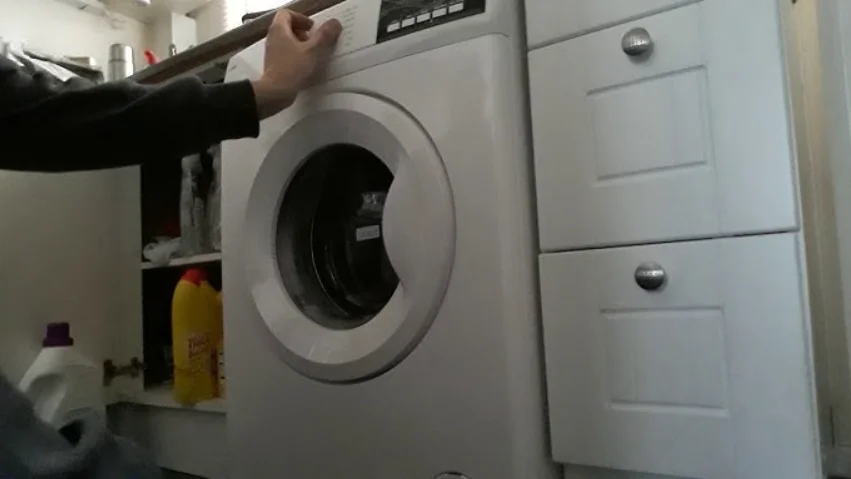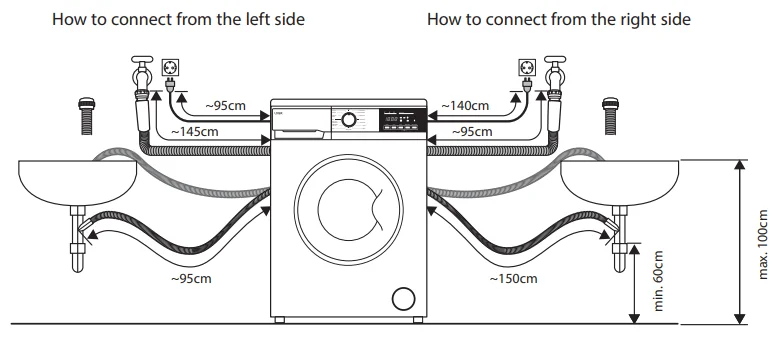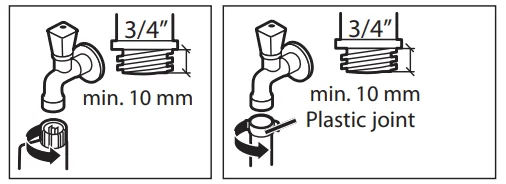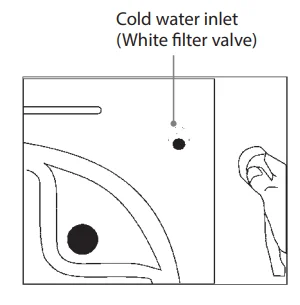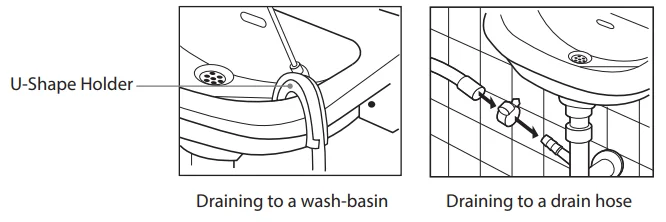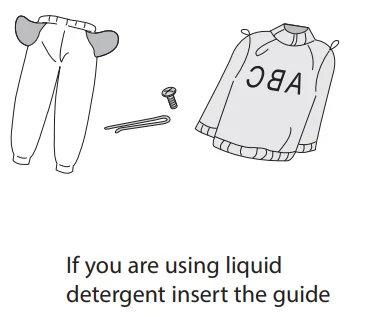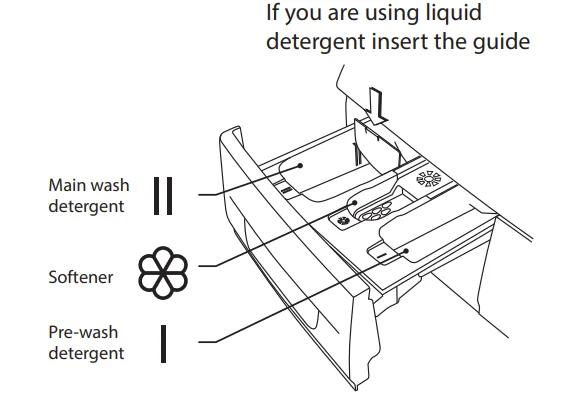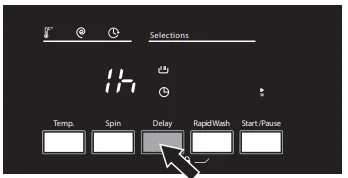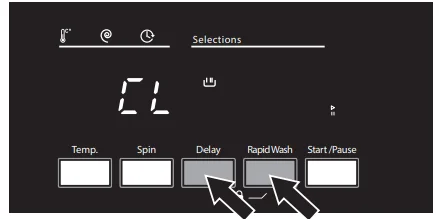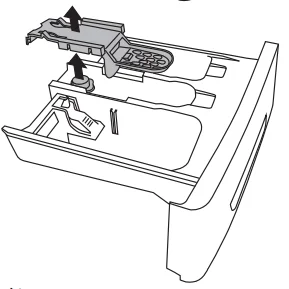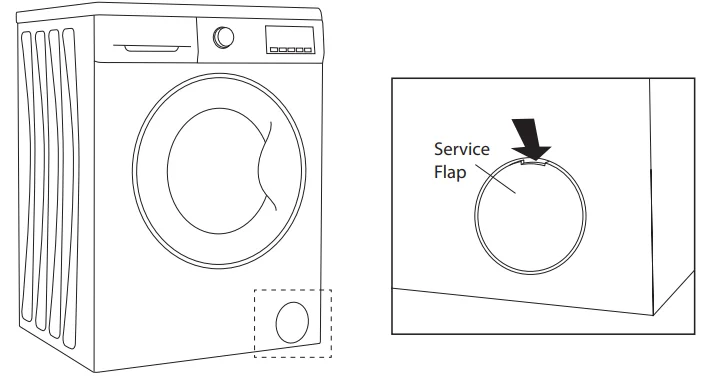
Logik L712WM20 1200-Spin Washing Machine
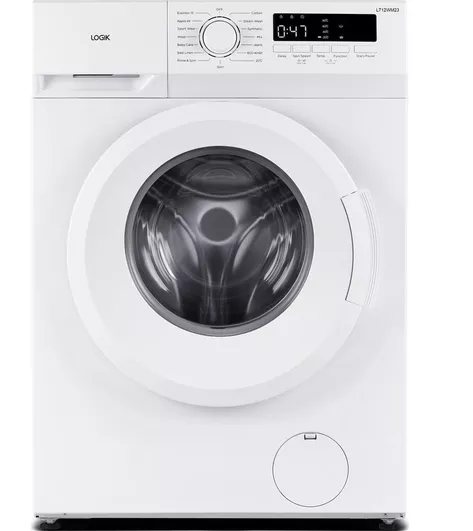
Unpacking
Remove all packaging from the unit. Retain the packaging. If you dispose of it, please do so according to local regulations. The following items are included: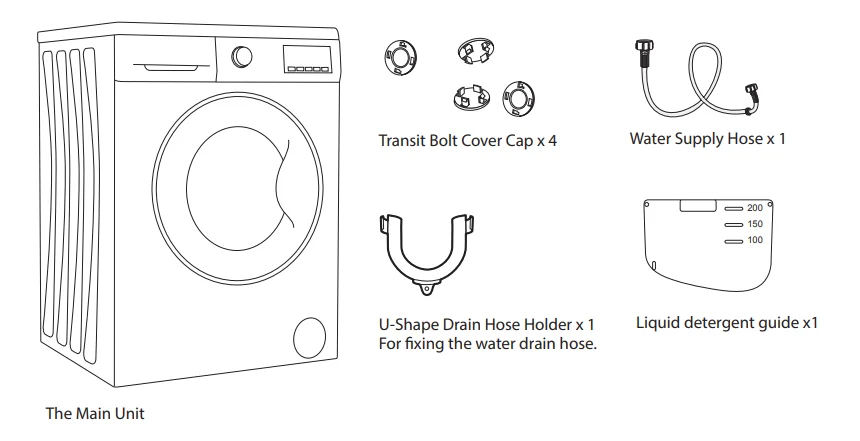
INSTALLATION
Removing the Transit Bolts
Four transit bolts keep the interior of the washing machine in place while it’s being moved. They need to be removed before installation. Use a spanner (not supplied) and follow the instructions detailed below.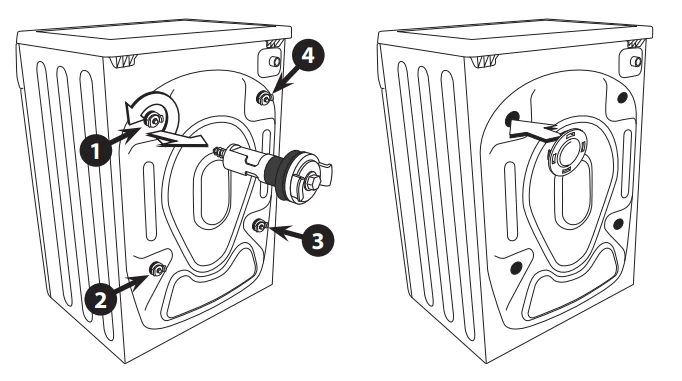
To remove the transit bolts:
- Ensure the unit is fully disconnected from the mains power by unplugging it from the mains.
- Unscrew the four (4) transit bolts.
- They are located at the rear of the washing machine. Use a spanner (not included) to loosen the four (4) transit bolts, then pull out the bolts horizontally. Ensure the plastic bolt guides (if any) are also removed.
- Snap in the plastic caps to cover the transit bolt holes.
Installing Your Washing Machine
Please read and follow the instructions carefully.
- In addition to the instructions mentioned here, special regulations of the relevant water and power supply companies may apply. If in doubt, have the washing machine connected by a qualified technician.
- The washing machine is heavy – caution when lifting it. Do not lift by projecting components (e.g., washing machine door).
- Warning: Frozen hoses may tear or burst. Do not install the washing machine in outdoor areas or where there is a risk of frost.
- Lay hoses and cables in such a way that there is no risk of trapping or kinking.
Choosing the Right Location for Your Washing Machine
- Make sure there’s enough space for your washing machine.
- Install your washing machine on a flat, stable surface to avoid excessive vibration and noise.
- The ventilation openings in the base of the washing machine must not be obstructed by carpet.
- Start by tilting the washing machine backwards.
- One person should stand behind it, holding the rear of the top panel. The other person should grip the bottom feet at the front.
- We recommend that you entrust the installation of the washing machine to a qualified technician.
Hose and Cable Lengths
Levelling the Washing Machine
There are 4 levelling feet on the underside. They MUST be adjusted to make sure the washing machine is level.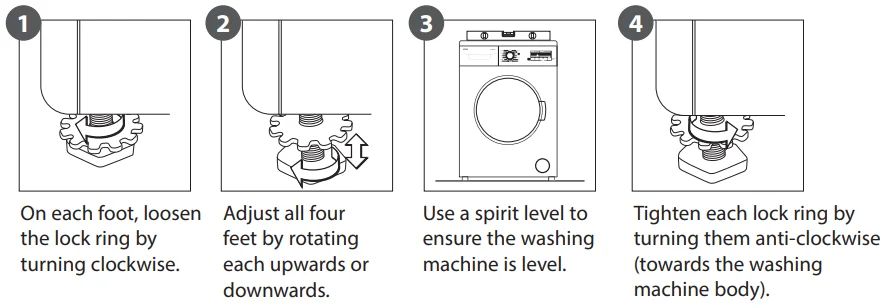
Ensure all four lock rings are tightened securely. Check the feet are still bolted to the washing machine – if they’re unbolted, the washing machine will move around.
Water Supply Hose
Points to remember
- Follow the instructions in this section to avoid water leaks.
- Don’t connect the hose to a combination tap.
- Don’t twist, squash, modify, or cut the hose.
- This machine is designed to connect to the cold water supply. Do not connect to the hot water supply.
- Use only the new water supply hose supplied. Old hose sets should not be reused.
- The mains water pressure must be 0.1MPa – 1MPa.
- If your washing machine is delivered in freezing weather conditions, leave it at room temperature for 24 hours after you’ve set it up before using it. This ensures there’s no ice blocking the water supply hose. If your water supply hose freezes, add 2 or 3 litres of warm water to the drum. Then run a “Spin” only programme.
Connecting the Water Supply Hose
- To prevent leakage from the connection joints, ensure the rubber washer seals are fitted to each end of the water supply hose. Do not use without the seals in place.
- Fit the straight end of the water supply hose to the cold water tap.

- Connect the angled end of the white-headed hose to the water inlet valve on the machine. Hand-tighten the plastic parts of the connections. If you are unsure, please call a qualified plumber.
- Open the tap slowly and check that there are no leaks around the connection joints.

Draining to a Sink or Wash-Basin
- Secure the drain hose in position so it can’t drop out of the basin.
- Don’t block the basin’s drain outlet, and make sure that the drainage through is sufficient to prevent overflowing.
- Don’t let the tip of the drain hose dip into the drained water, as this can cause the water to flow back into the washing machine.

Connecting to the Mains Supply
For your safety:
- Do not use a mains plug adapter or extension cable.
- If the mains cable or mains plug is damaged, disconnect from the mains, stop using them, and call a qualified technician for assistance.
- The mains cord of your washing machine is equipped with an earthed plug. This plug must always be inserted into an earthed socket capable of supplying 13 Amps. If you don’t have such a socket and fuses in your house, please call a qualified electrician.
First Time Use
Some water may be left in your machine due to tests carried out during production. To dispose of this water, it is recommended to perform the first washing operation with the programme (Cotton 90ºC) and without laundry by inserting ½ portion of detergent in the main detergent (II) compartment of the detergent drawer.
Product Overview
The unit
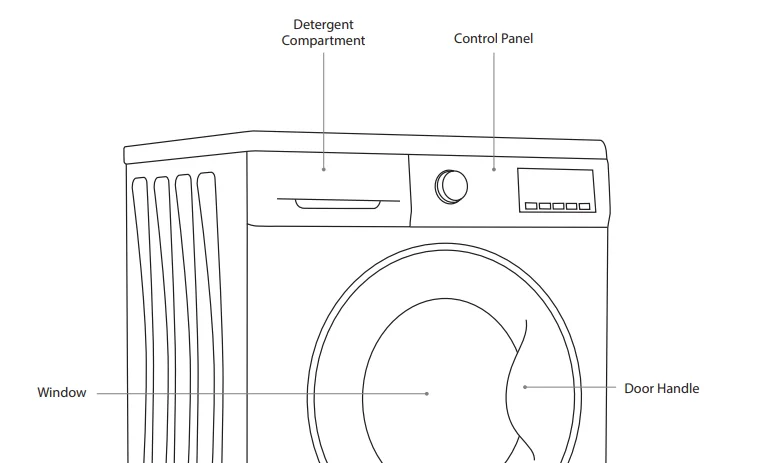
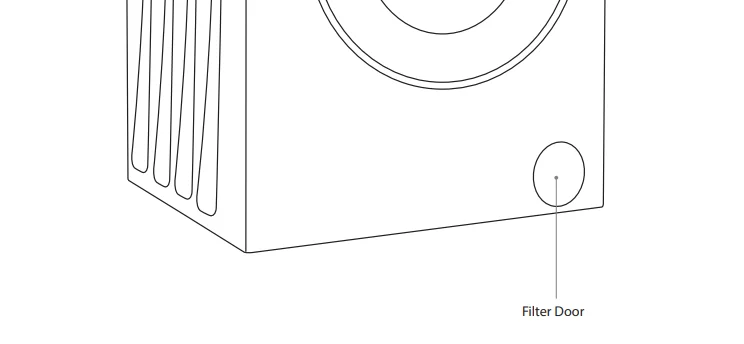
Control Panel
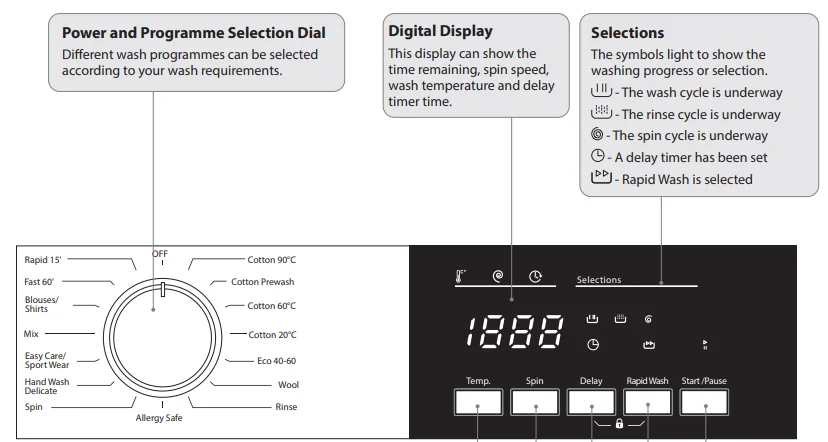
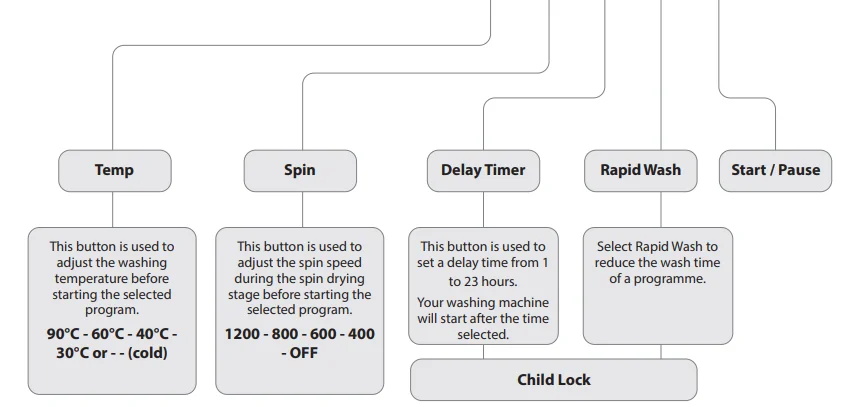
Caution: If you want to cancel any programme running:
- Switch the programme knob to the OFF position.
- Your machine will stop the washing operation, and the programme will be cancelled. (Ensure the Child Lock is off; otherwise, the original programme will continue.)
- To empty the water accumulated in the machine, switch the programme knob to any programme.
- Your machine will perform the necessary discharge operation and cancel the programme.
- You can then select a new programme.
Preparation
Read the following to understand how best to prepare your laundry for washing.
Preparing Laundry
- Check that pockets do not contain any objects that may damage your clothes and the washing machine.
- To prevent any large, heavy objects (e.g., buckles, large buttons, etc.) from hitting the glass door, turn your clothing inside out or remove the heavy objects. These could damage your laundry or the washing machine.
- For small items, use a washing net.

Adding Detergent and Softener
- Add detergent into the appropriate dispenser.
- Apply the softener before you start washing.
- Apply detergent and softener according to the washing amount, the soiling level, the water hardness in your area, and the manufacturer’s instructions for these products.
- For slightly dirty clothes, do not pre-wash and put a small amount of detergent in compartment 2 (II) of the detergent drawer.
- For excessively dirty clothes, select a programme including pre-washing, use ¼ of the detergent to be used in the detergent drawer in compartment 1 (I) and the remaining amount in compartment 2 (II). Dilute viscous fabric softener and fabric conditioner with water. Prevent blockage of the overflow. The maximum level is 40ml.

- Do not use the washing machine when the detergent drawer is removed. It may cause a water leak, or it may not work normally.
- If you forget to add detergent, you can drain the washing machine by running a spin-only programme. Then you can add detergent and start the programme again. Detergent only reaches the drum when water flushes through the detergent drawer.
- To prevent powdered detergent from staying in the drawer, dry the inside of the drawer with a cloth. Make sure the powder isn’t lumpy when you add it to the drawer.
- If the rinse cycle isn’t removing all the detergent from your wash, use less detergent.
- Softener should not exceed the MAX level in the compartment.
- Wash out the unused softener with a splash of water or a damp cloth after the programme has finished.
- You can use your liquid detergents in all programmes without prewashing. For this, fit the liquid detergent level plate from the accessories bag into the 2nd compartment of the detergent drawer and set the amount of liquid detergent according to the levels on this plate. Remember to detach the liquid detergent plate when done.
- Do not put too much laundry or detergent into the washing machine. It may cause issues with the washing machine or laundry.
- Use detergents, softeners, and other additives suitable for automatic washing machines only to prevent excessive foaming.
Selecting the Programme
Here are the available programmes, additional functions, and option settings. Spin speed can be selected separately for certain programmes.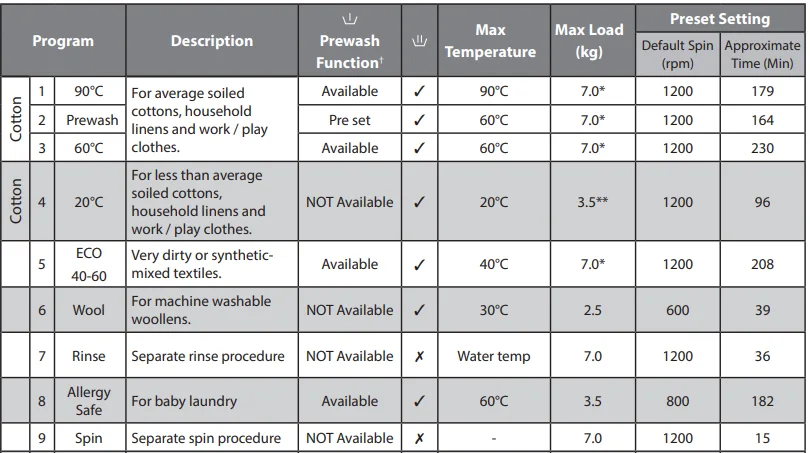
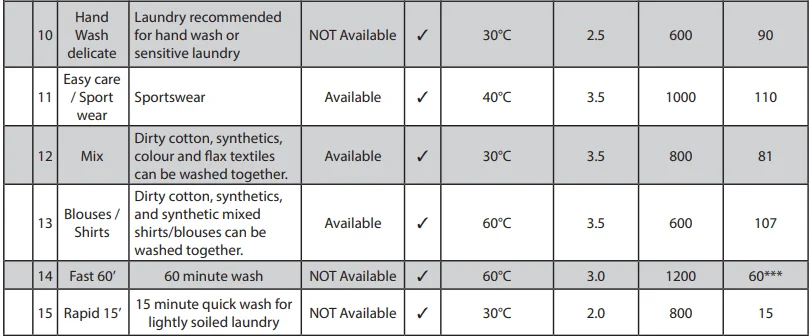
- According to regulations 1015/2010 and 1061/2010, programme 3 and programme 4 are respectively the ‘Standard 60°C cotton programme’ and the ‘Standard 40°C cotton programme’.
- The Eco 40-60 programme can clean normally soiled cotton laundry declared to be washable at 40°C or 60°C together in the same cycle, and this programme is used to assess compliance with EU ecodesign legislation.
- For all washing programmes, please follow the detergent recommendations on the garment label or on the detergent’s packaging.
- Washing times depend on the programme type, ambient water temperature, and wash load (weight and type).
- Energy and water consumption will vary according to wash load and type, extra functions, tap water, and ambient temperatures.
- The actual water temperature may differ from the declared cycle temperature.
- Your washing machine will automatically detect if you have only inserted half a load or less of laundry; it will automatically reduce the washing time, water consumption, and energy in some programmes.
- Your washing machine has an Auto Balance feature. Washing times will be longer if the laundry in the drum needs to be balanced.
Wash Setting
First washing operation
Some water may be left in your machine due to tests carried out during production. To dispose of this water, it is recommended to perform the first washing operation with the programme (Cotton 90ºC) and without laundry by inserting ½ portion of detergent in the 2nd compartment of the detergent drawer.
Standard Washing
- Pull the door handle and put the laundry in the drum. Make sure no laundry gets caught in the door.
- Close the door and turn the Programme Dial to select your wash programme and water temperature.
- Adjust the temperature (if required). The temperature cannot be set higher than the programme’s set temperature.
- Adjust the Spin Speed (if required).
- Select any Optional Functions.
- Add detergent to the detergent drawer. The quantity of detergent will depend on the amount of laundry, the degree of soiling, and the water hardness. Use the amount of detergent suggested on the packaging of the detergent.

- Press the Start / Pause button to start the washing.
- “End” will be displayed when the programme is complete.
Manual Soaking
To manually soak your laundry, press the Start / Pause button a few minutes after the wash programme has started, when the drum is full of water. The washing machine will suspend the laundry to soak it in the water. After your desired soaking time, press the Start / Pause button, and the machine will continue the previous wash.
Half-Load Detection System
Your machine features a half-load detection system. In case you load the machine to approximately half or less than the maximum laundry capacity, your machine will run so as to save washing time, water consumption, and energy in some programmes. When the half-load function is active, the machine can complete the programme you have set in a shorter time.
Optional Functions
Depending on the programme you select, you can combine different optional functions.
- Press the button of the optional function you would like to select.
- If the indication of the function button remains lit, it means that the function has been selected.
- If the indication of the function button is flashing, it means you cannot use that additional function for the wash programme you selected.
Reason for non-activation:
- The optional function you want to use in the washing programme you have selected is not applicable.
- Your machine has passed the stage during which the optional function you want to select would be implemented.
- It is not compatible with an optional function you have selected previously.
Washing Water Temperature Selection
You can select the washing water temperature with the Temp button. You can gradually decrease the washing water temperature between the maximum temperature of the selected programme and cold washing by repeatedly pressing the Temp button. If you have missed the washing water temperature you want, continue, and the temperature selection will loop back around.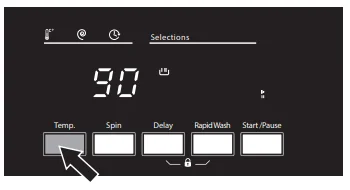
Temperature Cycle
90° – 60° – 40° – 30° – and — (cold)
Spin Speed
You can adjust the spin speed by pressing the Spin button. Only a lower spin speed than the one of the selected programme can be selected. Spin speeds selectable are: 1200 – 1000 – 800 – 600 – 400 – or — (no spin).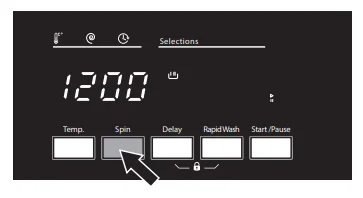
Delay Timer
- You can set a delay timer on your wash programme. The delay timer will then start the wash programme after the time that you set has expired. For example, if the time is now 4 pm and you set a 2-hour delay timer, your washing programme will start at 6 pm.
- Press the Delay Timer button to cycle through the delay times starting from 1 hour up to 23 hours.

How to Set the Child Lock
The Child Lock prevents children from accidentally stopping programmes. It only locks the control buttons, not the Programme Dial. Switch the washing machine on.
- When the washing machine is operating, press and hold the Delay and Rapid Wash buttons for 3 seconds. The letters ‘CL’ will be displayed for a few seconds, showing that the child lock is active. If any button is pressed or the Programme Dial is turned, the letters ‘CL’ will flash in the display.
- Press the buttons for 3 seconds to unlock and switch the child lock off.

Selecting a Rapid Wash
On some programmes, you can select to add a Rapid Wash to the programme; this will reduce the wash time. Press the Rapid Wash button to add a Rapid Wash. The symbol![]() will appear in the display. If the symbol
will appear in the display. If the symbol![]() flashes and then disappears from the display, it’s not possible to add a Rapid Wash to the selected wash programme.
flashes and then disappears from the display, it’s not possible to add a Rapid Wash to the selected wash programme.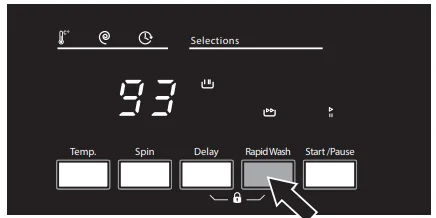
Finishing Programme
- Your machine will stop by itself as soon as the programme you have selected finishes.
- The door lock will release, and “End” will show in the display.
- Turn the Programme Dial back to OFF.
Removing Laundry
- Open the washing machine door and remove your laundry.
- Remove any foreign objects to avoid the risk of rusting.
- Leave the door and detergent drawer open so that residual water can evaporate.
- If you have finished using the washing machine, turn off the water and mains supply.
Maintenance – Cleaning the Washing Machine
Cleaning the Drum
- Rust left inside the drum by metal articles should be removed immediately with chlorine-free detergent.
- Never use steel wool.
- We recommend that periodic cleaning of the washing machine be done every 2 months. For periodic cleaning, please use the Cottons-90 programme. When required, use limescale removers manufactured specifically for washing machines only.
Cleaning the Exterior of Your Washing Machine
- Clean the outside of your washing machine with a soft cloth and mild detergent such as kitchen detergent.
- Don’t splash water over the washing machine.
- Do not use cream cleansers, thinners, or products containing alcohol or kerosene.
Cleaning the Detergent Drawer and Siphon Plug
- Remove the detergent drawer by pulling and pressing gently on the rear centre part of the softener compartment.
- Wash out the old detergent from the drawer with water. (Use a cloth to clean the washing machine.) Residue detergent soon builds up if you don’t clean the drawer regularly, and can develop mould.
- Return the drawer to its original position.

- Disassemble the detergent drawer. Remove the siphon plug and clean any residual softener thoroughly.

- Replace the cleaned siphon plug and check that it is fitted properly.
Cleaning the Door Seal and Window
- Wipe the window and seal after each wash to remove lint and stains. If lint builds up, it can cause leaks.
- Remove any coins, buttons, and other objects from the door seal after each wash.
Cleaning the Drain Filter
Before cleaning the drain filter, first start the spin programme, then switch off and unplug the washing machine.
- Gently open the service flap. Place a suitable container under the service flap to catch the water.

- Carefully loosen the drain filter. Turn anti-clockwise until the water gently begins to run out; this is normal.
- Remove the filter once the water has stopped.
- Remove any lint and debris before carefully replacing the filter.

- Turn the filter clockwise and screw the filter back into place.
- Close the service flap.
Troubleshooting
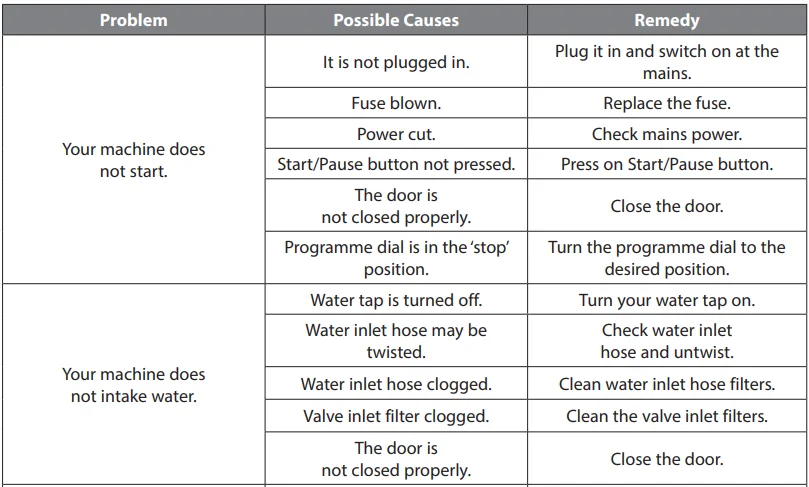
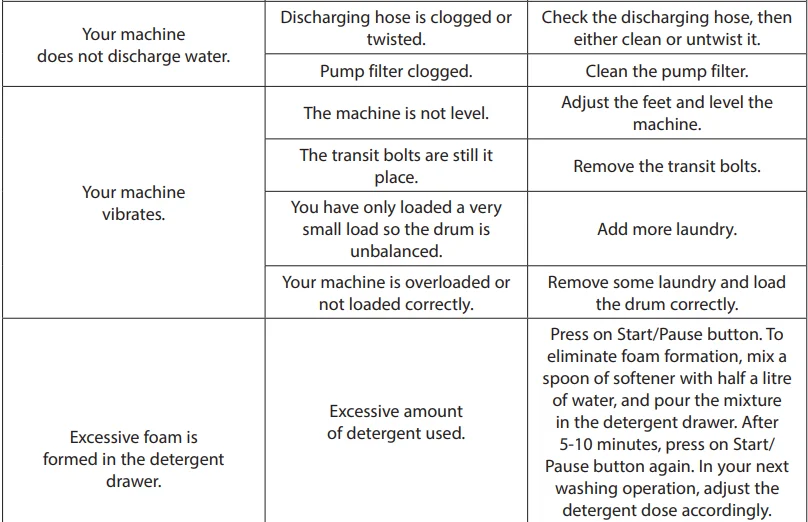

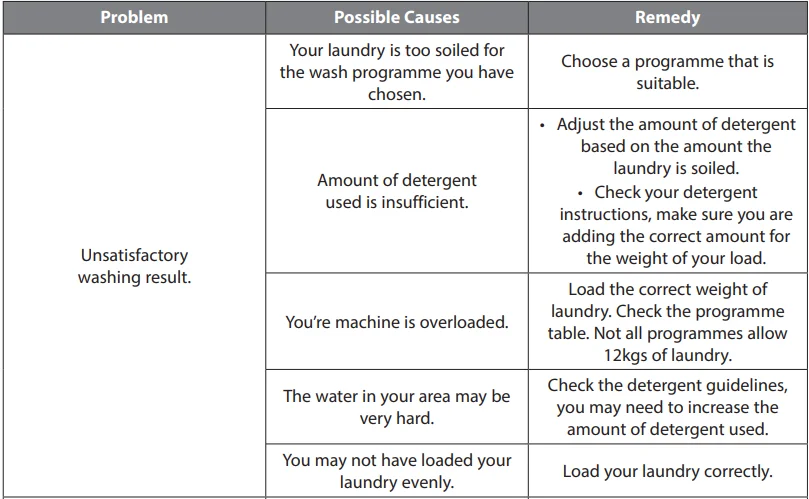
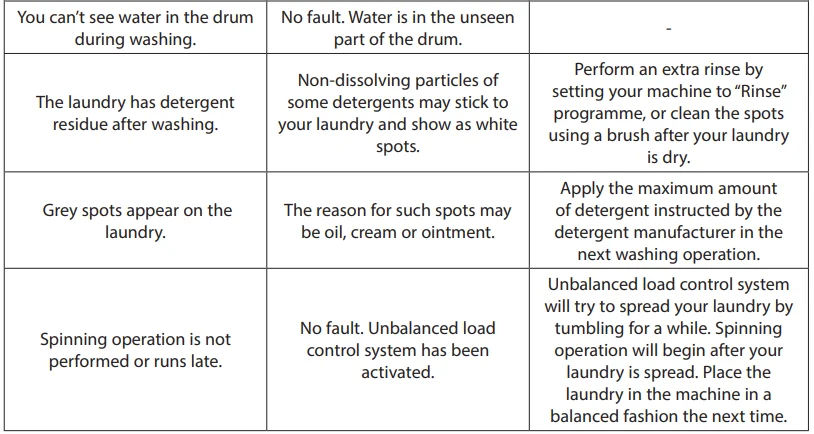
Visit www.partmaster.co.uk for more details or call 0344 800 3456 (UK customers only)
For More Manuals By Logik, Visit ManualsLibraryy.
Logik L712WM20 1200-Spin Washing Machine-FAQs
Why isn’t my Logik washing machine spinning?
If your Logik L712WM20 isn’t spinning, the issue may be with the door lock or interlock system. Ensure the door is securely closed before starting a wash cycle. If the problem persists, the door safety switch might need checking or replacement.
What is the capacity of the Logik L712WM20?
This model has a 7kg drum capacity, ideal for small to medium households of 3–5 people. It can handle large items like bed sheets while remaining efficient for smaller loads.
What does the CL code mean on my Logik washing machine?
The CL code indicates that the Child Lock feature is active. To disable it, press and hold the Temp and Eco/Rapid buttons together for about 3–4 seconds until the display clears.
How can I unlock my Logik washing machine door?
Unplug the washer and wait five minutes to allow the door lock to cool and release. If it remains stuck, gently tap around the door latch area while pulling the handle to open.
What does the OE error code mean?
The OE code signals a water overflow error. This occurs when the washer’s sensor detects too much water in the drum. Check the drain hose and water inlet valves for blockages or malfunction.
How do I remove the transit bolts from my Logik washing machine?
Transit bolts secure the drum during delivery. To remove them, loosen the four bolts on the rear panel using a spanner, then pull them out completely before first use.
How do I level my Logik washing machine?
Rotate each of the four adjustable feet to balance the machine. Use a spirit level to ensure the washer sits evenly on the floor to prevent vibration during spin cycles.
Why are my clothes still wet after the spin cycle?
Excess detergent or an unbalanced load can cause a slow spin or “suds lock.” Try reducing detergent use and evenly redistributing clothes before restarting the spin cycle.
What happens if I forget to remove the transit bolts?
Leaving transit bolts installed prevents the drum from suspending properly, causing loud vibrations or even machine damage during operation. Always remove them before first use.
How often should I clean my washing machine and filter?
Clean your washer and drain pump filter monthly to maintain performance and prevent odors. If you wash heavily soiled items or have pets, consider cleaning it more frequently.

